Artist Statement | Image Gallery | Home | Close Portfolio (and return to SMP index)
Artist Statement
Jesus
Trees
or The Gospel According to Landscape
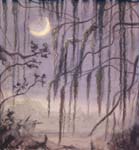
My artwork seeks to express the basic Gospel message of Christianity in
an accessible, non-traditional way. Subject matter such as mine can be
approached in many different ways, including preaching and teaching. My
intentions, however, are more subtle and open-ended. I want to inspire
personal reflection-to invite thought and discussion in a comfortable
environment, stimulating the visual sense as a gateway to the spiritual
sense. To do this I try to establish a unique relationship between the
viewer and the artwork-I engage them initially on a visual level by establishing
an intimate visual encounter with a painting that draws the viewer into
the space of the painting. This then serves as a starting point for intellectual,
emotional, or spiritual responses that might happen on a personal level
as the viewer thinks about the title (often based on a passage of scripture)
in relation to the painted forms they see. This deeper personal engagement
can continue in the viewer's mind long after having looked at the artwork.
In doing this I hope to bring the Gospel message-that Jesus died in our
place to bring forgiveness and reconciliation with a loving God-to a new
place of understanding by means of a meaningful, engaging, visual experience.
It is important to me that these responses emanate from the viewer's visual
engagement with my artwork. Though one might see desire of the artist
to persuade the viewer in my art making, unlike propaganda or even a tract,
the message is not so overt as to overpower the visual image. In that
sense the experience is visual before being textual; the artwork establishes
a strong image and a spiritual sense before directing attention to the
explicit message of Jesus. The watercolor medium, the landscape genre,
and the pictorial language of my painting style are all ways that I draw
the viewer in visually to give a voice to the message of Jesus.
Watercolor as a medium has often been regarded as the medium of a hobbyist,
a medium for making studies and sketches, even a medium for book illustration-all
traditionally accessible and approachable uses. At the same time, watercolor
requires a trained, skilled hand and lots of planning and patience to
keep the paint from turning into a soggy, brown mess. The genre of watercolor
has a less "heavy" or serious nature than oil painting. This
allows for a more intimate engagement with the viewer, who can easily
approach a watercolor, and not feel overwhelmed by a huge canvas, ornate
frame or altarpiece. The physicality of the medium also contributes to
the artwork's approachability-the paint itself is not thick or opaque;
instead, the luminosity and texture of the paper underneath the transparent
paint attract the eye.
My decision to deal with Christian subject matter in the genre of landscape,
rather than with traditional figurative paintings, creates a metaphorical
visual language in order to speak to a larger, more diverse audience.
The presence of the figure in spiritual art is powerful-sometimes too
powerful. It can read allegorically, symbolically, or be understood to
represent a scriptural character, thus forcing the spiritual meaning into
the context of biblical narratives. While such works can inspire and make
sense to believers, they can also distance if not alienate people who
don't believe or are unfamiliar with the Bible. I've chosen to avoid the
use of the figure and direct depiction of religious images, and to work
exclusively in landscape, using it as a metaphor to depict spiritual concepts.
Viewers are familiar with the landscape-they are familiar with the genre,
and most likely regularly see some form of nature as they go about their
daily routine. My choice to provide the viewer with something so familiar
and accessible can help communicate spiritual themes in a fresh way. Most
viewers have seen image after image of robed biblical figures in traditional
paintings, and they may not as readily relate to something that they have
little chance to encounter in life. But viewers might walk outside and
see forms in the trees or the sky that echo visual motifs in my paintings,
such as the glowing clouds in Invitation or the twisting and sometimes
cross-shaped branches in the triptych piece or in Redemption in Sight.
And as they consciously or unconsciously remember the forms they saw in
my paintings tied to the message of bent and trapped humanity and salvation
through Jesus, they receive the opportunity to reflect on the message
in a new way.
My painting style tends to personify the landscape. All the elements of
the picture feel whimsical, alive, and full of movement. Old Testament
prophets and poets wrote of such animation in creation. In proclaiming
their coming salvation, Isaiah declared to the Jews, "You will go
out in joy and be led forth in peace; the mountains and hills will burst
into song before you, and all the trees of the field will clap their hands."
(Isaiah 55:12) The book of Psalms holds many songs reflecting on creation's
voice of worship. Jesus himself, when rebuked for allowing people to proclaim
him as Messiah, replied, "if they keep quiet, the stones will cry
out." (Luke 19:40). These ideas emerged in my paintings as I began
to enjoy my work more and loosen my style, resulting in landscapes with
"dancing" trees and resounding sunbeams that work together to
evoke a sense of spirituality. In creating this spiritual quality with
visual harmony in my paintings, I hope to direct attention to God's approachable
nature and unfathomable love as proclaimed in scripture and embodied in
his Son, Jesus. To do this, I use titles that point to this explicit subject
matter, often referring to a specific passage from the Bible.
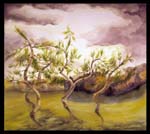
This is where the second level of meaning in my art takes place. As I
said before, it is important to me that the viewer's first level of engagement
in my work is visual. But once drawn in, a second level of meaning in
my art happens when the viewer reads the title and has to reconcile the
fact that the artwork somehow deals with Christianity. The viewer must
connect the title with the image they see before them, which on the surface
has no direct illustrative relationship to it.
In all of this I hope to create artworks in which visual metaphors offer
my audience a new way of thinking about-and looking at-the Gospel message.
A visual metaphor does not directly illustrate an idea, but rather makes
meaning by connotation, creating images that can be seen to parallel the
message of salvation through Jesus, for a new understanding of that message.
My paintings simply want to say, "Hey, come look at Jesus this way."
For example, my gnarly, twisted tree depictions in the three-paneled series,
when paired with their titles and biblical citations, can suggest the
idea of humanity fallen from God, especially in the first painting, Where
I Found Myself.. Yet the trees themselves are not "sinful,"
and shouldn't be understood as a literal representation of fallen humanity.
However, the visual depiction of confusion and entanglement, combined
with other elements, such as a dark cloud hiding the sunlight, can suggest
the idea, and present it in a way that text alone can't communicate.

After engaging the viewer on a visual level, then encouraging thought
on a more intellectual level, my artwork invites further varied responses
on a more personal level of meaning. The viewer can decide to simply enjoy
the landscape at face value. They can debate or wrestle with the message
or its presentation. Or, if curious, he or she can go and explore any
cited (or un-cited) biblical passages, do some searching, and engage with
the art and its meaning on a more personal level. Any of these responses
can happen immediately, as the viewer looks at the painting and is provided
with a Bible in the gallery. However, it's closer to my intent that as
the viewer returns to everyday life, what they have seen and reflected
on will remain with them as they experience nature again or think about
Christianity-two subjects now tied to each other by my artwork.
My visual metaphor differs from artworks that make their meaning through
symbolism. My work is not symbolic in this sense. The landscape elements
in my paintings are not specific visual representations of spiritual concepts.
The presence of the sun in my landscapes shouldn't read as a code for
God, and trees, although often figurative as a result of my style, don't
directly stand for people.
Traditional religious painting has often employed symbolism as a tool.
For example, in Vermeer's paintings of everyday objects, all the elements
directly stood for a spiritual idea. This isn't what I'm doing. I'm opening
the door for a wider interpretation in order to speak to a more diverse
audience, while still holding the explicit subject matter of relationship
with God through Jesus.
I choose to express myself through visual metaphor rather than symbolism
because I find it subtle and personal-a visual language unique to me,
yet one that is open to a more subjective interpretation and understanding.
I've often planned my paintings with specific metaphors in mind, but allow
for viewers to wrestle with the interpretation themselves. Viewers can
have different visual interpretations of the same image, and even the
same message. For example, the painting Lover Knocking on the Ancient
Doors, suggests a door or a passageway in the intimate sense of space
portrayed: perhaps a personal door to invite Jesus into as the Revelation
reference in the title conveys, or perhaps a crossover from darkness to
light as the tones in the painting might hint at. The visual metaphor,
while open to individual understanding and interpretation, lets the authority
of the spiritual truth rest with the Biblical references.
Can artwork still express a subject matter as specific as the Gospel of
Christ without using overt iconography? Art historian Salley Promey, after
examining American religious visual culture, affirms that it can; that
content, style, use, and context strongly indicate the cultural presence
of religion in artwork. In America, where separation of church and state
eliminated the institutional expression of religion, the landscape became
the language of Christian spirituality (Promey, 2-3). Nineteenth Century
American painters such as George Inness depicted specific biblical subject
matter, such as Valley of the Shadow of Death, yet also painted landscapes
without specific Christian subject matter, such as Peace and Plenty, which
were considered equally religious. The development of romanticism along
with increased Protestant proclamation of the biblical concept that anyone
can worship God anywhere without the mediator of the church developed
the understanding of the landscape as a religious subject (Koerner, 97).
My paintings better fit into the context of Romanticism and modern American
landscape painting, which was intimately connected to Christian spirituality
and the idea that God has revealed himself to humanity through nature,
an idea that echoes from the Bible. "For since the creation of the
world God's invisible qualities-his eternal power and divine nature-have
been clearly seen, being understood from what has been made, so that men
are without excuse." (Romans 1:20)
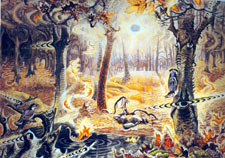
My use of metaphor in a language unique to myself with its subtle nature
and its encouragement of unbound personal interpretation relates to two
spiritual landscape painters: American 20th Century watercolorist Charles
Burchfield and German Romantic Caspar David Friedrich. Burchfield invented
visual conventions in his style of abstract mark-making to express moods
or surpassing and indescribable ideas relating to nature in his landscapes.
He didn't try to represent a particular subject in his landscapes, but
rather sought to evoke a mood or emotion based on his conception of the
subject. These moods often had a fantastical or a spiritual feel to them,
as Burchfield's style intensified natural occurrences, often showing multiple
activities simultaneously, or as he invented visual conventions such as
the repetition of linear forms to express movement or even sound, such
as in Autumnal Fantasy. These conventions had obscure meanings, and remained
a personal sign of the artist-never a specific code (Baigell, 170). The
viewer could read their own meaning into the specific style of brushstrokes
or the abstracted forms, subjectively feeling the mood that Burchfield
sought to convey.
Caspar David Friedrich was also a painter who, while deeply committed
to making art with Christian spirituality embedded in its meaning, believed
in the need for the artist to create a more personal language rather than
rely on conventional symbolism. Friedrich talked about the artist's need
to create a "manner," or a personal painting language (in the
mark-making and picture construction) to re-express what the soul has
understood-a spiritual eye guiding his formal eye (Hoffman, 22). He said,
"The painter should not paint merely what he sees in front of him
but also what he sees within him. If he sees nothing within himself, however,
then he should refrain from painting what he sees in him." (Hoffman,
26). As I paint, I make meaning by using my personal style to visually
express the spiritual truths I know and experience.
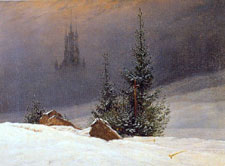
The subject matter I'm dealing with-the Gospel message-is ultimately personal
and intimate; the God my artwork centers around is an approachable being.
Intimacy with a now-approachable God is what Christ's death and resurrection
brought about, and that's the idea that my paintings echo visually, specifically
in the sense of space they create. For comparison and contrast we can
look again at my favorite two spiritual landscape painters. Caspar David
Friedrich, though painting landscapes on relatively small canvasses, painted
wide, open panoramas, which made the viewer feel small-and awestruck-in
relation to what they saw. Charles Burchfield, on the other hand, though
his paintings were often larger in size than Friedrich's, portrayed a
more intimate sense of space, putting the viewer up close to the experience.
Decisions of whether or not to include figures in the paintings also contribute
to the sense of intimacy and the viewer's ability to draw near to and
identify with the painting. In many of Friedrich's paintings, a figure
appears in the landscape, a sort of pilgrim, struggling up a mountain
to the cross, or wandering through the woods. Looking at the figure, the
viewer is forced into the role of spectator, detached from the spiritual
experience, observing the scene from a distance. In Burchfield's paintings,
and in my own, the absence of the figure increases the level of intimacy.
The visions of the artist become the visions of the viewer, who essentially
becomes the "pilgrim" when looking straight into the scene as
if he or she is participating in it. And when the viewer connects the
spiritual idea to the visual image in front of them, they are confronted
personally with the inherent meaning, and are left to decide for themselves
what to do with it.
I'll return once again to the example of intimacy in the three-paneled
series to discuss the intimate sense of space in my work. In the painting
Where I found Myself, the viewer feels almost trapped among the twisted
branches, as if they'd like to crawl through them, but can't. This helps
tie image to the idea of being trapped in a lifestyle of rebellion from
God. The third painting Entrance Beyond the Curtain offers a "walking
space" out of the mass of trees, perhaps even inviting the viewer
to draw near and encounter the water or sky beyond. This visual sense
of clearing and a passageway connects to the cited biblical passage describing
the entrance beyond the temple curtain into the holy of holies by the
work of Jesus.
My intentions behind my work and my approach to my subject matter differ
from traditional religious painting in Christendom in terms of viewer
relationship to the work and in terms of what I'm trying to express. For
example, unlike Duccio's Maestà, a narrative and iconic altarpiece
in the Siena Cathedral, I'm not creating an object of devotion; my paintings
are not part of a worship ritual. They are not framed elaborately on an
altar, nor are they housed in a church as an inherent part of the context.
Neither am I depicting a narrative of Biblical events like the many panels
in the Maestà, meant to inspire instruction or contemplation. My
paintings don't seek to tell a story in a sequence, but rather, point
to that same central story through a more universal visual system-the
language of landscape. Instead of confronting the viewer with a series
of events where they play the separated role of spectator, I'm inviting
the viewer into an intimate, approachable visual setting where he or she
can think about the meaning of a spiritual concept while looking at it
expressed visually. I don't assume that the viewer fully knows the story
of Christ or is familiar at all with the Bible. However, I do depend on
the viewer's ability recognize that this artwork deals with Christian
and biblical ideas (when they read the title and any other textual information
I may provide), and that they have the ability to seek and find out more
about the meaning if they so desire. That's why a Bible placed in the
gallery accompanies my paintings. I don't intend for only Christians to
appreciate my work; non-believers are perhaps the main audience because
of the context my work is shown in.
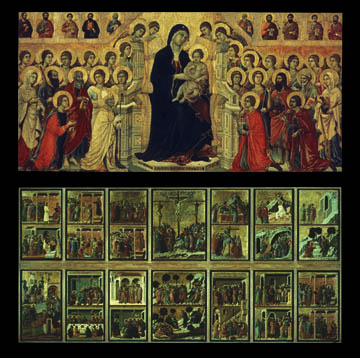
My work also differs from many traditional Christian religious paintings
in the overall message it seeks to convey. Much of Western religious painting
sought to affirm the power of the Catholic Church by visually overwhelming
the viewer and employing iconography that drew attention to the church's
authority. Returning to the example of Duccio's iconic altarpiece in the
Siena Cathedral, a pilgrim would have been awestruck by the bright hues
and glistening gold in the candlelight of a dark, spacious cathedral.
This grand painting displayed Siena's wealth with expensive ultramarine
pigment, lavish gold inlay, and intricate garment ornamentation. Its depiction
of Mary holding the Christ child flanked by specific Sienese saints drew
attention to the city, which worshipped Mary as its patron saint. My artwork,
however, is not about glorifying an institutionalized church or heroes
of the faith often incorrectly regarded as intermediaries.
Unlike religious icons or objects of devotion, the directness of my paintings
suggests no intermediary church, priest, or person standing between humanity
and God besides Christ himself. I focus solely on the individual's relationship
with God through visual metaphors that hint at a spiritual encounter that
could be experienced by anyone who has ever seen a tree or a sunset-or
heard the message of Christ. Jesus often talked about hearing the Word
and responding to it: "He who has hears let him hear," echoes
throughout the Gospel accounts. He was all about opening up people's eyes,
both literally and spiritually. Perhaps my work is also about opening
up eyes-engaging people on a visual level, and prompting individual thought
on a deeper level. I could say, "He who has eyes, let him see!"
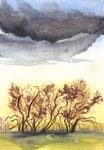
Works Cited:
1. Hofmann, Werner. Caspar David Friedrich. New York: Thames & Hudson Inc., 2000.
2. Koerner, Joseph Leo. Caspar David Friedrich and the Subject of Landscape. London: Reaktion Books, 1990.
3. Burchfield's Seasons. New York: Kennedy Galleries, Inc., 1982.
4. Baigell, Matthew. Charles Burchfield. New York: Watson-Guptill Publications, 1976.
5. Morgan, David. Promey, Sally M. Exhibiting the visual culture of
American religions. Valparaiso: Valparaiso University, 2000.
5. The Bible. New International Version. Grand Rapids, MI: Zondervan
Publishing
House, 1986.
1. Hofmann, Werner. Caspar David Friedrich. New York: Thames & Hudson
Inc., 2000.
Discusses Friedrich's "spiritual eye" that guided his formal
eye, examines different senses of pictoral space in Friedrich's work,
composes a collection of works from his lifetime. One chapter focuses
on three of his most important works: the Tetchen Altar, The Monk by the
Sea, and The Abbey in the Oak Wood.
2. Koerner, Joseph Leo. Caspar David Friedrich and the Subject of Landscape.
London: Reaktion Books, 1990.
Talks about Friedrich's new approach to religious art-through landscape,
coming out of a history of iconographic altarpieces, and leading into
a new genre of secular landscape. Includes discussion of allegory vs.
symbolism, the use of figures in the landscapes, and how this new movement
was encouraged by Protestantism's belief that anyone can approach God
without the church as a mediator.
3. Homer, William Innes and Lloyd Goodrich. Albert Pinkham Ryder Painter
of Dreams. New York: Harry N. Abrams, Inc., 1989.
Traces the development of Ryder's paintings in light of his fantastical,
dreamer-like way of thinking. Discusses his skillfulness in form and color
to create moody paintings. A good visual reference for moonlit scenes.
4. Burchfield's Seasons. New York: Kennedy Galleries, Inc., 1982
A collection of images from an exhibition, with notes about the history
of some of his works. This has been a useful visual reference.
5. Baigell, Matthew. Charles Burchfield. New York : Watson-Guptill Publications,
1976.
Focuses on the development of and changes in his style throughout his
career, dealing mostly with his moody landscapes. A good discussion of
artistic techniques and visual characteristics of Burchfield's work.
5. Weekly, Nancy. Charles E. Burchfield : the Sacred Woods. Buffalo, N.Y. : Albany : Burchfield Art Center ; State University of New York Press, 1993.
Talks a lot about Burchfield's spirituality in relation to his artwork, and how it developed throughout his lifetime, from his fear of organized religion to often pantheistic beliefs, to Christianity. Describes specific paintings and seasons in his career affected by his spirituality, romanticism, and love of the fantastical. A good visual reference.
6. Morgan, David. Promey, Sally M. Exhibiting the visual culture of
American religions
Images from an exhibition on American Religious visual culture at the
Brauer Museum. Includes an essay by Promey challenging the historical
consideration of religion as something separate from art and American
culture, and introducing the return of religion to art as American culture
becomes increasingly visual. Also includes essay by Morgan giving an overview
of the exhibition while discussing key issues in religious imagery.
7. Kirschner, Melanie. Arthur Dove Watercolors and Pastels. New York:
George Braziller, Inc., 1998
Describes Dove's spontaneous and fresh depictions of his personal connection
to the landscape by means of watercolor and pastel. Use of such portable
and intimate media enabled him to capture first impressions of color and
form upon initial observation, and contributed to the development of his
abstract style.
8. Eldredge, Charles C. Reflections on nature: small paintings
by Arthur Dove, 1942-1943
A good visual reference for unconventional ways of portraying the landscape
in abstract language. Dove's work is very unlike my style, but it was
helpful to see something so different in these quick sketches. His use
of color and line to express the essence of what he saw in the landscape
helped me think about and see the landscape in new ways.
9. Kandinsky, Wassily, Concerning the Spiritual in Art. New York: Dover
Publications, Inc.,1977.
A discussion of spirituality found in forms and colors of art, written
by a 20th Century abstract painter whose work was influenced by music
and spirituality.
10. Rookmaaker, H. R. Modern Art and the Death of a Culture. London:
InterVarsity Press, 1970
An analysis of contemporary art (contemporary to the previous generation)
in light of major historical movements; a discussion of Christianity and
the arts, of truth and beauty. Asserts that art, like nature, needs no
claimed meaning or justification other than its existence as a work from
the hands of the Creator. There is no such thing as specifically "Christian
art" as if a Christian artist should only make work to adorn a church
or preach a message; instead, Christian-made art should be skillful, healthy,
resulting from a sound insight on reality, and coming out of the fullness
of the artist's humanity.
11. The Bible. New International Version. Grand Rapids, MI: Zondervan
Publishing
House, 1986.